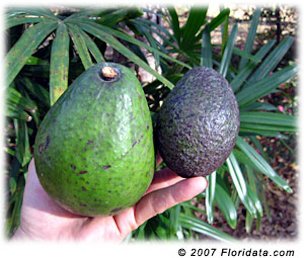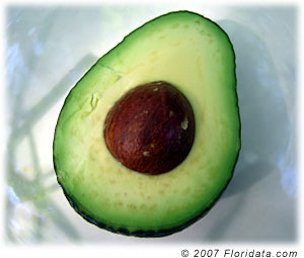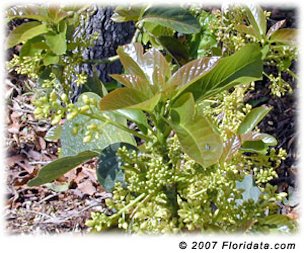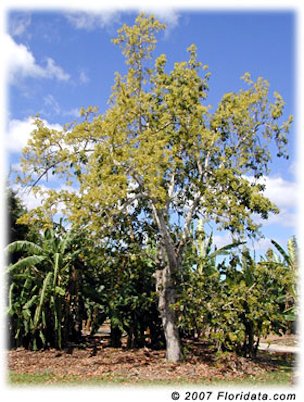From Floridata
by
Steve Christman
Persea americana
Common
Names: avocado, alligator pear, aguacate, palta
Botanical
Family: Lauraceae, the laurel Family
Description
The
avocado tree has shiny evergreen, elliptic leaves 4-8 in (10-20 cm)
long. It is a much-branched, medium-sized tree, to 60 ft (18 m) or more
in height. The little flowers are greenish and not at all showy. They
are interesting in that each flower opens twice. First the female part
(pistil) ripens and opens; then the flower closes and some 24 hours
later it opens again with the ripe stamens releasing their pollen. This
practically insures that the flower will not be self pollinated. The
avocado tree is cultivated for its delicious and highly nutritious
fruit. Avocado fruits contain up to 30% oil and have the highest
protein and oil content of any fruit. Fruits may be pear shaped to
round, and smaller than a golfball to almost as big as a football,
depending on the variety.

A West Indies type avocado is on the left and a dark
rough-skinned Mexican type avocado is to the right.
There
are three principal races or groups of avocado: Mexican, Guatemalan and
West Indian, named for the areas where they were originally cultivated.
Mexican avocados have foliage with an anise scent and small fruits
about the size of a plum, with black or purple smooth skin. Guatemalan
avocados have larger, blackish-green, rough-skinned fruits. The West
Indian avocado has the largest fruits, up to 2 lbs (1 kg), with smooth
light green skin. Mexican avocados have the highest oil content; West
Indian the lowest. The important cultivars now in commercial production
are mostly hybrids between these three original races. There are at
least 500 named cultivars. One of the most popular cultivars is
'Fuerte', a Mexican-Guatemalan hybrid with smooth-skinned, shiny green,
pear shaped fruits. 'Hass', a Guatemala type, has rough-skinned fruits
that turn purple when fully ripe. Most of the commercially grown
hybrids are self fertile.

A sliced avocado reveals it's creamy deliciousness.
Location
Persea americana
is native to Central America, but is now cultivated throughout the
tropical and subtropical world. Archaeologists have found that avocados
have been cultivated in Central America for more than 7000 years. Major
exporters of avocado today are Mexico, the United States, Israel, Kenya
and South Africa. The largest avocados are grown in Hawaii.
Culture
Light: Grow in full sun.
Moisture: Avocados must be grown in well drained soil, but with frequent watering. Allow the soil to dry out before watering deeply.

The avocado's tiny blossoms are held on branched
stalks and appear at the same time as new foliage.
Hardiness: USDA
Zones 8 - 11. The Mexican avocado varieties are the most hardy,
withstanding winter temperatures to 16 F (-9 C); some can be grown as
far north as Charleston, South Carolina. West Indian avocados cannot
tolerate temperatures much below freezing. Guatemalan types are
intermediate, hardy to 24 F (-5 C) or so. 'Mexicola', "Gainesville' and
'Winter Mexican' are among the hardiest varieties available. One of the
tastiest varieties is 'Pollack', a West Indian type that is killed by
temperatures below freezing.
Propagation: Named
avocado cultivars are propagated by grafting to seedling or clonal
rootstocks. Grafted plants will produce fruit in 2-3 years. The large
seeds of avocado can be suspended in a glass of water with tooth picks
so that the wider half lies below water. They will germinate in a few
weeks and can then be transplanted to a pot or outdoors. Such seedlings
may bear fruit of uncertain quality in 8-12 years.

Avocado trees are evergreen but drop last years
foliage just as the current season's is appearing.
Usage
Nothing
compares with the understated rich buttery taste of a ripe avocado in a
salad, guacamole dip, or just cut in half and eaten with a spoon.
Avocados should be ripened off the tree. Picked green and firm, an
avocado will ripen in a week or two in a warm room; considerably longer
in the refrigerator. Left on the tree to ripen, avocados become mushy
and develop an undesirable flavor.
Features
Avocado is closely related to the North American red bay (Persea borbonia) and swamp bay (P. palustris), although neither of these has an edible fruit. Altogether there are about 150 species of Persea, occurring in North and South America and southeast Asia. Most are evergreen trees and shrubs.
|
|